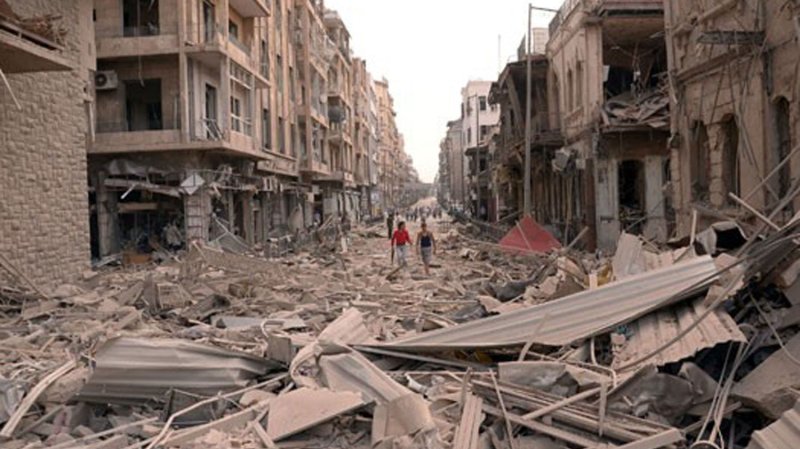In this photo released by the Syrian official news agency SANA, Syrians walk through the rubble at the scene where multiple bombs explosions hit the center of Aleppo, Syria on October 3, 2012. UPI |
License Photo
BEIRUT, Lebanon, Dec. 13 (UPI) -- The Assad regime's broadside of Soviet-era Scud ballistic missiles against rebel forces marks a major escalation in Syria's 20-month-old civil war and could be a warning to Western powers not to intervene.
Syrian President Bashar Assad's military fired at least six Scud-type weapons this week from the An Nasiriyah airbase near Damascus , targeting the Sheik Suleiman military base outside the northern city of Aleppo, which rebel forces had captured, U.S. officials reported.
The missile launches were reported Wednesday. They were detected by U.S. surveillance satellites used to monitor the fighting.
Rebel forces have taken large areas of the north, bordering Turkey, and the oil-rich east, as well as part of Damascus from which regime forces have not been able to dislodge them despite air strikes and heavy counterattacks on the ground.
One report indicated that the weapons fired were probably North Korean-built Hwasong-6 missiles, an advanced variant of the Soviet-made Scud. It's carries a guidance system and a warhead of around 1,800 pounds of high explosive.
But Scuds are notoriously inaccurate. They were designed as "area weapons," meaning they are most effective when fired in large numbers as large targets like troop concentrations or population centers rather than individual targets.
"There seems to be something spectacularly pointless about lobbing conventionally armed and inaccurate missiles in the hope of quelling a nationwide insurgency," observed British analyst Shashank Joshi of London's Royal United Services Institute.
But he noted: "Intentionally irrational acts may be intended to send the message that intervention could incur heavy costs, particularly with Western allies like Turkey, Jordan and Israel within range of Syrian chemical-armed missiles.
"Missiles are deterrents and actually firing them ... tends to concentrate the mind in Western capitals."
If Assad's generals had sought to take out particular installations or buildings in Aleppo, airstrikes would probably have been more effective. So it would seem the regime's intention was "shock and awe" to terrify its enemies and cause as many casualties and much destruction as possible.
Oddly, there was no indication from the Free Syrian Army and other rebel forces around Aleppo concerning the missile attacks or their effects.
U.S. officials said there was no sign the Scuds were armed with chemical weapons, the use of which would have caused an outcry in the West and the Arab world. That would have provided Assad's enemies with a pretext to intervene militarily in a bid to end the bloodbath in which around 40,000 people are reported to have been killed since the uprising against Assad began March 15, 2011.
The Americans and their allies have warned Assad that using Syria's considerable arsenal of chemical weapons and nerve agents against the rebels and their supporters would be a red line he would cross at his peril.
But even though the regime appears to have used conventional warheads this time, its use of missiles could have been an act of defiance to show the Americans it won't be intimidated.
The Syrian broadside was unleashed after the United States and a coalition of more than 100 other countries formally recognized the Syrian, mainly Sunni Muslim, opposition.
That bestowed upon it an international legitimacy it has long sought in its struggle to bring down the regime dominated by minority Alawites.
The missile strikes also came after senior officials in Russia, one of the regime's key allies, acknowledged that the regime could fall and that it had drawn up plans to evacuate Russian citizens.
That fell far short of any move to abandon Assad as his long-fractious enemies made military and political gains after setting aside their differences to form a more cohesive and effective opposition front at the constant urging of the Americans and others.
But it was one more setback for Assad and his inner circle and could indicate a growing sense of despair in the regime.
It's not clear whether Assad will unleash further missile strikes. Much will depend on what kind of damage the Scuds caused in the north.
Syria has several hundred Scud variants and other surface-to-surface missiles, mainly of Soviet and Russian origin.
It also manufactures Scuds and other weapons at its two main production centers at Aleppo and Homs in underground facilities built with Chinese, North Korean and Iranian help.





